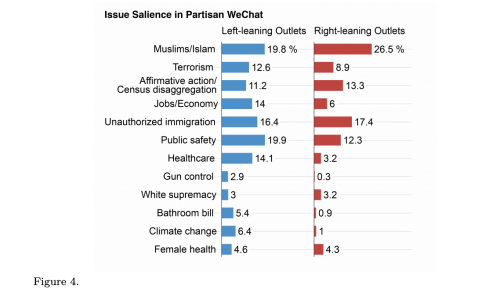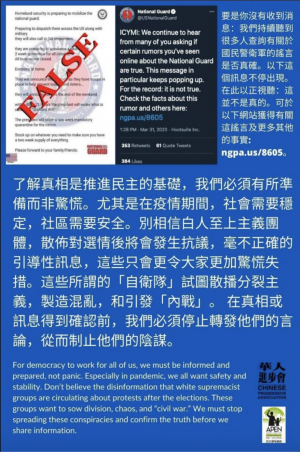Misinformation on WeChat
WeChat is an ethnic media hotspot, delivering media produced by and for a specific ethnic group. In this case, Chinese Americans, many of whom are first generation immigrants who downloaded the app with the intention of using it to keep in touch with relatives abroad. Parallel to the spread of misinformation targeting older adults on Facebook, a similar phenomenon is occurring through WeChat. This is possible in part due to the curation method of the app that leads to asymmetric polarization. [1]
Contents
Background
Due to China’s Great Firewall, most mainstream social media platforms are unavailable in China without the use of a VPN. Because of this, WeChat is one of the main social media platforms in China. Not only that, but it is one of the few applications that can be used in China and outside of China. However, WeChat is much more than just a social media platform. WeChat is also capable of handling monetary transactions between users, similar to Venmo. In addition, it also provides resources for those with language barriers. These two are just some of the functions that WeChat has. Essentially, WeChat is a “super app” that has functions that span many different applications that are used in America.[2]
Causes
Partisan Outlets
The presence of partisan news outlets on WeChat helps contribute to the asymmetrical polarization, with right-wing outlets producing more articles per month and drawing significantly more views than left-wing outlets. Since these are ethnic media outlets, news that is reported specifically is of interest to Chinese Americans. Misinformation becomes easily spread when popular topics in WeChat don’t align with topics on mainstream English or Chinese speaking media. Some of these topics include affirmative action, undocumented immigration, and Muslims/Islam. This happens because when there is no prominent or mainstream reporting of especially salient topics on WeChat, there is a lack of counternarratives and fact-checking.[1]

Curation
Another contributor to WeChat’s misinformation problem is due to its relatively algorithm-less design. Users encounter content by either subscribing directly to news accounts, a chronologically sorted news feed where content is shared by friends, and circulated in invite-only groups. This type of curation makes information flow very socially driven, as information is shared by organically created, trusted networks and not suggested to the user. Out of both personally and socially curated content, social curation plays a larger role in information exposure. In a study conducted by the Tow Center for Digital Journalism at Columbia, 87% of respondents who are WeChat users read articles posted by friends, 79% read articles from private groups, and 57% actively read from their subscribed news accounts.[1] These private groups can range from tight-knit group chats to a form more like Facebook groups, where large groups are topically driven or members loosely have something in common. The larger groups are constantly evolving and splitting to form narrower and narrower echo chambers, where misinformation easily spreads unchecked. This decentralized format in combination with the attention economy allows for clickbait headlines, emotional hysteria, editorializing, and lack of source checking to run rampant.[1] On top of this, Wechat is entirely dependent on individual users to report false information, providing ideal conditions for misinformation to breed.
Censorship
Unlike social media in the United States, WeChat is heavily regulated by the Chinese government. One of the methods that they use for censoring content on WeChat is the use of keywords.[3] Any article, post, or message posted on WeChat can be censored through the searching of keywords.[2] In addition, any individual or group that speaks out against the Chinese government on WeChat can also face consequences.[4] They do not experience the same type of free speech rights that we do in the United States.
Another form of censorship on WeChat that the Chinese government has used is stopping the media from exposing misinformation. Cracking down on the media originally started because of the propaganda being put out by the Communist party and President Xi Jinping. Many people were suspicious of the propaganda being put out and the media took it upon themselves to reveal the truth. Despite their efforts, there is not much the media in China can do in terms of exposing misinformation because of the Chinese government.[5]
Affected Users
The sharing of misinformation disproportionately targets older Asian Americans. There has been a recent rise of conservatism among first generation Chinese immigrants. 35% of Chinese Americans supported Trump in 2016, with this statistic being higher with first generation immigrants.[6]
Recent Examples of Misinformation
- Nearing the 2020 presidential election, a flyer was being spread around claiming that the U.S. Department of Homeland Security was dispatching the National Guard and military to control riots on election day.[7]
- Information about a mainstream media coverup of Joe Biden and his son Hunter Biden was also circulated, they were allegedly being investigated for racketeering and charges.[7]
Efforts to Combat Misinformation
Some groups such as the Chinese Progressive Association and NoMelonGroup are attempting to debunk some of the false stories spread on WeChat with posts containing official sources and combat sensationalized stories with counter-narratives. However, these efforts remain overshadowed by the misinformation itself and are not viewed nearly as much as the original article. Faced with the asymmetric polarization of the app along with the social curation method of content sharing, this information is at a disadvantage in being spread as widely and quickly as more provocative misinformation.[1][7]

White House Response, Potential Ethical Implications
In response to not only the glut of misinformation, but also concerns about censorship and data collection on the app, the former presidential administration had spearheaded banning the app. Those opposed to the ban cited First Amendment rights as a reason why the action would be ethically ambiguous.[8] Users of the app are on it to stay connected with relatives and friends in China, where multiple Western social media outlets are banned. George Shen, a technology executive in the Boston area, argues that the free existence of WeChat is a threat to the First Amendment itself, as the extent of the false information muffles free speech and discourse.[8] The question of whether the existence of echo chambers dug within WeChat spreading misinformation swings more towards a right of free speech or an abuse of it remains central to the debate.
References
- ↑ 1.0 1.1 1.2 1.3 1.4 1.5 “WeChatting American Politics: Misinformation, Polarization, and Immigrant Chinese Media” (15 May 2018. Retrieved on 9 March 2021.), [1]
- ↑ 2.0 2.1 "The Logic of a US WeChat Ban" (September 2020. Retrieved on 17 March 2021), [2]
- ↑ "It’s crucial to understand how misinformation flows through diaspora communities" (11 December 2020. Retrieved on 17 March 2021), [3]
- ↑ "On Tech: WeChat unites and divides in America" (6 October 2020. Retrieved on 17 March 2021), [4]
- ↑ "Fake News Is Rampant Even Under Tight Chinese Filters; Crackdown on professional media erodes those outlets' role as public watchdogs" (7 December 2016. Retrieved on 17 March 2021), [5]
- ↑ “2016 Post-Election National Asian American Survey” (16 May 2017. Retrieved on 11 March 2021.), [6]
- ↑ 7.0 7.1 7.2 7.3 “Misinformation Image on WeChat Attempts to Frighten Chinese Americans Out of Voting” (2 November 2020. Retrieved on 9 March 2021.), [7]
- ↑ 8.0 8.1 “Chinese censorship invades the U.S. via WeChat” (7 January 2021. Retrieved on 10 March 2021.), [8]